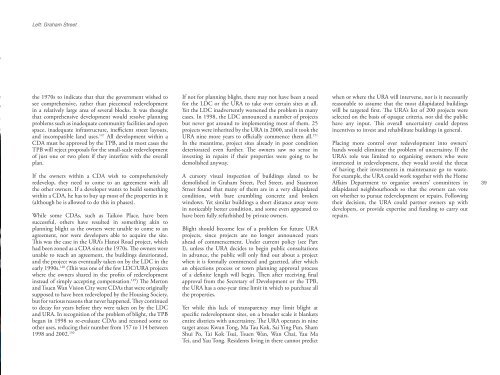Treating the Symptoms - A Critical Review of ... - Civic Exchange
Treating the Symptoms - A Critical Review of ... - Civic Exchange
Treating the Symptoms - A Critical Review of ... - Civic Exchange
- No tags were found...
Create successful ePaper yourself
Turn your PDF publications into a flip-book with our unique Google optimized e-Paper software.
Left: Graham Street<strong>the</strong> 1970s to indicate that that <strong>the</strong> government wished tosee comprehensive, ra<strong>the</strong>r than piecemeal redevelopmentin a relatively large area <strong>of</strong> several blocks. It was thoughtthat comprehensive development would resolve planningproblems such as inadequate community facilities and openspace, inadequate infrastructure, inefficient street layouts,and incompatible land uses. 147 All development within aCDA must be approved by <strong>the</strong> TPB, and in most cases <strong>the</strong>TPB will reject proposals for <strong>the</strong> small-scale redevelopment<strong>of</strong> just one or two plots if <strong>the</strong>y interfere with <strong>the</strong> overallplan.If <strong>the</strong> owners within a CDA wish to comprehensivelyredevelop, <strong>the</strong>y need to come to an agreement with all<strong>the</strong> o<strong>the</strong>r owners. If a developer wants to build somethingwithin a CDA, he has to buy up most <strong>of</strong> <strong>the</strong> properties in it(although he is allowed to do this in phases).While some CDAs, such as Taikoo Place, have beensuccessful, o<strong>the</strong>rs have resulted in something akin toplanning blight as <strong>the</strong> owners were unable to come to anagreement, nor were developers able to acquire <strong>the</strong> site.This was <strong>the</strong> case in <strong>the</strong> URA’s Hanoi Road project, whichhad been zoned as a CDA since <strong>the</strong> 1970s. The owners wereunable to reach an agreement, <strong>the</strong> buildings deteriorated,and <strong>the</strong> project was eventually taken on by <strong>the</strong> LDC in <strong>the</strong>early 1990s. 148 (This was one <strong>of</strong> <strong>the</strong> few LDC/URA projectswhere <strong>the</strong> owners shared in <strong>the</strong> pr<strong>of</strong>its <strong>of</strong> redevelopmentinstead <strong>of</strong> simply accepting compensation. 149 ) The Mertonand Tsuen Wan Vision City were CDAs that were originallysupposed to have been redeveloped by <strong>the</strong> Housing Society,but for various reasons that never happened. They continuedto decay for years before <strong>the</strong>y were taken on by <strong>the</strong> LDCand URA. In recognition <strong>of</strong> <strong>the</strong> problem <strong>of</strong> blight, <strong>the</strong> TPBbegan in 1998 to re-evaluate CDAs and rezoned some too<strong>the</strong>r uses, reducing <strong>the</strong>ir number from 157 to 114 between1998 and 2002. 150If not for planning blight, <strong>the</strong>re may not have been a needfor <strong>the</strong> LDC or <strong>the</strong> URA to take over certain sites at all.Yet <strong>the</strong> LDC inadvertently worsened <strong>the</strong> problem in manycases. In 1998, <strong>the</strong> LDC announced a number <strong>of</strong> projectsbut never got around to implementing most <strong>of</strong> <strong>the</strong>m. 25projects were inherited by <strong>the</strong> URA in 2000, and it took <strong>the</strong>URA nine more years to <strong>of</strong>ficially commence <strong>the</strong>m all. 151In <strong>the</strong> meantime, project sites already in poor conditiondeteriorated even fur<strong>the</strong>r. The owners saw no sense ininvesting in repairs if <strong>the</strong>ir properties were going to bedemolished anyway.A cursory visual inspection <strong>of</strong> buildings slated to bedemolished in Graham Street, Peel Street, and StauntonStreet found that many <strong>of</strong> <strong>the</strong>m are in a very dilapidatedcondition, with bare crumbling concrete and brokenwindows. Yet similar buildings a short distance away werein noticeably better condition, and some even appeared tohave been fully refurbished by private owners.Blight should become less <strong>of</strong> a problem for future URAprojects, since projects are no longer announced yearsahead <strong>of</strong> commencement. Under current policy (see PartI), unless <strong>the</strong> URA decides to begin public consultationsin advance, <strong>the</strong> public will only find out about a projectwhen it is formally commenced and gazetted, after whichan objections process or town planning approval process<strong>of</strong> a definite length will begin. Then after receiving finalapproval from <strong>the</strong> Secretary <strong>of</strong> Development or <strong>the</strong> TPB,<strong>the</strong> URA has a one-year time limit in which to purchase all<strong>the</strong> properties.Yet while this lack <strong>of</strong> transparency may limit blight atspecific redevelopment sites, on a broader scale it blanketsentire districts with uncertainty. The URA operates in ninetarget areas: Kwun Tong, Ma Tau Kok, Sai Ying Pun, ShamShui Po, Tai Kok Tsui, Tsuen Wan, Wan Chai, Yau MaTei, and Yau Tong. Residents living in <strong>the</strong>re cannot predictwhen or where <strong>the</strong> URA will intervene, nor is it necessarilyreasonable to assume that <strong>the</strong> most dilapidated buildingswill be targeted first. The URA’s list <strong>of</strong> 200 projects wereselected on <strong>the</strong> basis <strong>of</strong> opaque criteria, nor did <strong>the</strong> publichave any input. This overall uncertainty could depressincentives to invest and rehabilitate buildings in general.Placing more control over redevelopment into owners’hands would eliminate <strong>the</strong> problem <strong>of</strong> uncertainty. If <strong>the</strong>URA’s role was limited to organising owners who wereinterested in redevelopment, <strong>the</strong>y would avoid <strong>the</strong> threat<strong>of</strong> having <strong>the</strong>ir investments in maintenance go to waste.For example, <strong>the</strong> URA could work toge<strong>the</strong>r with <strong>the</strong> HomeAffairs Department to organize owners’ committees indilapidated neighbourhoods so that <strong>the</strong> owners can voteon whe<strong>the</strong>r to pursue redevelopment or repairs. Following<strong>the</strong>ir decision, <strong>the</strong> URA could partner owners up withdevelopers, or provide expertise and funding to carry outrepairs.39
















